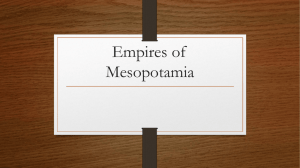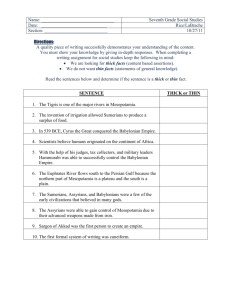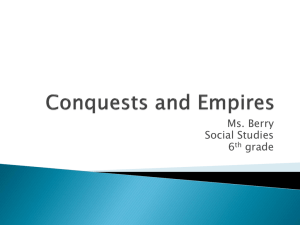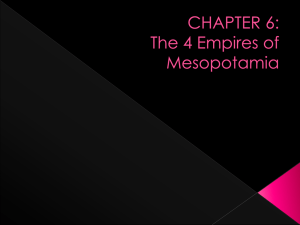Mesopotamian Empires: Akkadian, Babylonian, Assyrian, Neo-Babylonian
advertisement
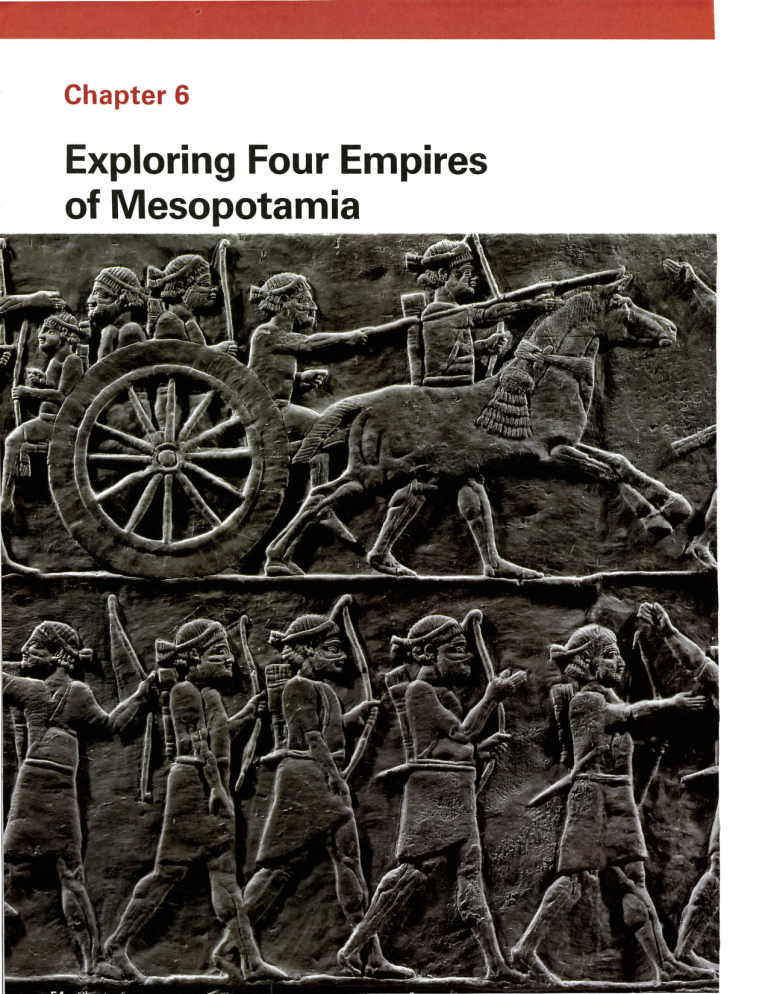
Chapter 6 Exploring Four Empires of Mesopotamia Chapter 6 Exploring Four Empires of Mesopotamia What were the most important achievements of the IVlesopotamian empires? 6.1 Introduction Ancient Sumer flourished i n Mesopotamia between 3500 and 2300 B.C.E. I n this chapter, you w i l l discover what happened to the Sumerians and who ruled Mesopotamia after them. The city-states of ancient Sumer were like small independent countries. They often fought over land and water rights. They never united into one group. Their lack of unity left them open to attacks by stronger groups. This timeline shows four empires About 2300 B.C.E., the Akkadians (uh-KAY-dee-unz) con- that ruled Mesopotamia during a quered Sumer. This group made the Sumerian city-states a part period of almost 1800 years. of an empire. A n empire is a large territory where groups of people are ruled by a single leader or government. Four Empires of Mesopotamia Akkadian Empire About 2300-2100 B.C.E Assyrian Empire About 900-612 B.C.E Groups like the Akkadians first conquer and then rule other lands. ^ EQYPT-< /• ARABIA-J , BAeVLONIft " """""" ••'«-... \ I n this chapter, you w i l l learn about four empires 2500 B.C.E. 1500 B.C.E. \0 B.C.E. 1000 B.C.E. / 500 B.C.E. that rose up i n Mesopotamia between 2300 and 539 B.C.E. They were the Akkadian - Empire, the Babylonian (bah-buh-LOH-nyuhn) Empire, the Assyrian (uh-SIR-ee-un) Empire, and the Neo-Babylonian Empire. •4 EGVPT > ' SYRIA /. ^\ ^YRIA ASSVRIA ARABMJ ^ ASSYHIA BWYLONtA _ -"V Babylonian Empire Aboutl792-1595 B.C.E Neo-Babylonian Empire About 605-539 B.C.E This Assyrian carving depicts soldiers marching off to battle. Exploring Four Empires of Mesopotamia 55 The Akkadian Empire, About 2300 B.C.E. 't\ Sea ^ • I Shubat-Enlil % Assur'l ASSYRIA ARABIAN PENINSULA 200 Ur 400 miles \; Modern coastline \ 200 400 kilometers Lambert Conformal Conic Projection y V-^ ^. Sea ^ Akkadian Empire, about 2300 B.C.E. The Akkadian military conquered 6.2 The Akkadian Empire the independent city-states of For 1,200 years, Sumer was a land of independent city-states. Sumer and united them under King Sargon. Then, around 2300 B.C.E., the Akkadians conquered the land. The Akkadians came from northern Mesopotamia. They were led by a great king named Sargon. Sargon became the first ruler of the Akkadian Empire. empire a large territory in which several groups of people are ruled by a single leader or government Sargon was both a strong king and a skilled general. He built his empire through effective military strategies. First, he assembled a large army. Then, he taught his soldiers to fight i n tight formations. Soldiers carrying shields stood at the front of the formation. Behind this line stood soldiers carrying spears. The spear carriers extended their weapons between the shields. Sargon used his military skills to w i n territory for his empire. After defeating the king of the city-state of U r u k , Sargon had gained control of all of Mesopotamia, including Sumer. To keep control of his empire, Sargon used very clever political strategies. He destroyed the walls of many cities to make it harder for people to rebel. He also demanded the loyalty of the governors of city-states. I f they were disloyal, Sargon replaced them w i t h his own men. A n d he became the first king to decree that his sons rule after his death. Sargon lived to be a very great age. His name soon passed into legend. He and the Akkadians had created the world's first empire. This was their greatest achievement. 56 Chapter 6 6.3 Life Under Akkadian Rule Sargon ruled his empire for 56 years. D u r i n g that time, he made the city of Agade (uh-GAH-duh), i n northern Mesopotamia, the empire's capital. He built up the city w i t h tributes collected from the people he conquered. Agade became a cultural center, with many beautiful temples and palaces. It was one of the richest and most powerful cities i n the world. capital a city that is the center of government tribute wealth sent from one country or ruler to another as a sign that the other is superior The Akkadians may have ruled Sumer, but the Sumerian culture lived on. The Akkadians farmed using the Sumerians' irrigation techniques. To record information, they used Sumer's system of cuneiform writing. They even worshipped the same gods and goddesses, although they called them by different names. Religion stayed central to the social order, and kings continued to rule i n the name of the gods. The Akkadians had their own cultural achievements. Over time, their language replaced the Sumerian language. I n art, they became especially well k n o w n for their skillful three-dimensional sculptures. Artisans also carved relief sculptures on stones. These carved stones are called steles. The Victory Stele is a famous example. It was created to celebrate a military victory by Sargon's grandson, King Naram-Sin. The stele shows Naram-Sin leading his victorious army up a mountain slope. Some of his enemies are crushed underfoot. Others die, flee, or beg for mercy. Sargon had hoped that his empire would last for a thousand years. But later kings found it difficult to rule such a large territory. The empire grew weak. After about 200 years, the Akkadian Empire fell to new invaders from the north. On the Victory Stele, King Naram-Sin is shown astallerthanthe other men. He wears a horned crown to make him look like a god. E x p l o r i n g Four Empires of Mesopotamia 57 King Hammurabi united iviesopotamia and made the The Babylonian Empire, About 1750 B.C.E. city-state of Babylon the capital Caspian Sea of the Babylonian Empire. /i SYRIA Mediterranean Sea "^Nineveh .Assur ASSYRIA '''"^ Jordan River Babylor^'^f, % ARABIAN PENINSULA 0 I 0 Modern coastline 1 200 200 400 miles 1 400 kilometers PordnrT^ ' S., Persian 550^ Lambert Conformal Conic Proiection vT 1 Babylonian Empire, about 1750 code of laws a collection of written laws and rules '^^.^ 25°N/ B.C.E. 6.4 Hammurabi and the Babylonian Empire For a time after the fall of the Akkadians, Sumer was once again a group of city-states. The next ruler to unite all of Mesopotamia was a king named Hammurabi (hah-muh-RAH-bee). Hammurabi was the king of Babylon (BAH-buh-luhn), a small city-state i n central Mesopotamia. After conquering the rest of Mesopotamia, Hammurabi made Babylon the capital of his empire. The region under his rule became k n o w n as the Babylonian Empire, or Babylonia. Hammurabi is best known for his code of laws, which he wrote from 1792 to 1750 B.C.E. Hammurabi used the code of laws to unify his empire and to preserve order. He based the laws not merely on his own authority, but on the word of the gods. Hammurabi claimed that the gods had told h i m to create laws that applied to everyone i n the empire. Laws that were based on the gods' w i l l could never be changed. The code of laws was written on a stele and placed i n a temple for everyone to see. Hammurabi's code was detailed. It covered many situations, such as trade, payment for work, marriage, and divorce. The code spelled out punishments for crimes, such as stealing or Hammurabi's code was carved causing injury. For example, i f a poorly built house were to on a stele so that all people collapse and k i l l its owner, then the builder could be put to would know their rights and death. I f the owner's son rather than the owner were killed i n responsibilities. the collapse, the builder's son could be put to death. 58 Chapter 6 Laws like this one seem harsh to us now. Yet Hammurabi's code was an important achievement. Although the laws and punishments d i d not treat all people equally, the code was the first set of laws to apply to everyone. 6.5 Life in the Babylonian Empire Babylonia thrived under Hammurabi. He worked to unite the people of his empire. He made the Babylonian god, Marduk (MAHR-dook), supreme over other gods. He built roads and created a postal service. Agriculture and trade flourished. Hammurabi was careful to maintain irrigation systems properly so that land remained fertile and provided plenty of food. Because the city of Babylon was on This woman is weaving cloth on the banks of the Euphrates River, it became an important center a simple loom. One end of the of trade. Babylonians traded w i t h people all along the Persian loom is tied around a tree or post, Gulf. They traded grain and woven cloth for wood, gold, silver, and the other end is tied around her back. precious gems, and livestock (animals). Trade helped the empire's economy. Many types of artisans used materials brought back from distant lands. The arts also flourished. Writers wrote historical poems, some of which survive to this day. Most important, Babylonian society was unusually fair for its time. The laws treated the various classes differently, but even slaves had some rights. Slaves could work elsewhere and keep their wages. They could own property. I f they saved enough money, they could even buy their freedom. Women also had more rights than they did i n most ancient economy the way a region or country uses resources to produce and sell or trade goods and services to meet people's needs and wants societies. Even though their fathers chose their husbands, women could own property. They could also keep money of their own. Hammurabi was proud of his achievements. He once wrote: I rooted out the enemy above and below. I made an end of war. I promoted the welfare of the land. ... I have governed them [the people] in peace. I have sheltered them in my strength. Exploring Four Empires o f Mesopotamia 59 At its peak, the Assyrian Empire extended from Egypt to the The Assyrian Empire, About 650 B.C.E. Persian Gulf. This vastterritory Caspian Sea was difficult to control and defend. * Nineveh -^-^'^/fe Assur; fupA ^SYRIA 'f'^neanSea^ ASSYRIA BABYLONIA ' j^Jordan Rive: Babylon* ""^~f'-L Jerusalem ARABIAN PENINSULA - \E ^ \ coastline M 400 miles . -1 ' — i ' 0 200 400 k i l o m e t e r s Lambert Conformal Conic Projection • -i Persian n,,if ( } Assyrian Empire, about 650 55=^ ^ 25 / / B.C.E. 6.6 The Assyrian Empire The line of kings begun by Hammurabi did not continue to rule Babylonia for long. Over the next several hundred years, a number of groups ruled parts of what had been the Babylonian Empire. The next great empire i n Mesopotamia was created by a warlike people called the Assyrians. Assyria lay to the north of Babylon. The Assyrians had lived in Mesopotamia for a long time. They had briefly established their own empire before Hammurabi conquered them. They rose to power again toward 900 B.C.E., when a series of rulers of Assyria began preparing for war. W i t h a newly trained army, the Assyrians began to expand their territory. The Assyrians were feared for their military might and their This carving shows an army using cruelty. Their greatest achievements were their new weapons a battering ram to breakthrough and their war strategies. They perfected the use of horses and the walls of a city. iron weapons i n battle. They also became greatly skilled at siege warfare. I n a siege, army soldiers camp outside a city and repeatedly attack it until the city falls. The Assyrians developed new ways of attacking cities. They were the first to use battering siege a military blockade and attack on a city to force it to surrender 60 Chapter 6 rams. These long, heavy beams on wheels were used for breaking down walls. The Assyrians also built moveable towers that were rolled up to a city's walls. Soldiers used the towers to climb over the walls. The Assyrians were often ruthless. They might iorce entire populations to leave areas they had recently conquered. The Assyrians spread tales of their cruelty far and wide. Creating fear among their enemies was part of the Assyrian military strategy. 6.7 Life Under Assyrian Rule The Assyrian Empire was ruled by powerful kings. Religion, however, remained very important i n the social and political order. Even kings were obliged to obey the gods. The Assyrians believed that their kings were special beings. To honor them, the Assyrians built beautiful palaces. The great palace i n the capital city of Nineveh (NIH-nuh-vuh) had many rooms. Some palaces were built on tall mounds, to raise them higher than the surrounding buildings. Huge sculptures of This winged bull with five legs winged bulls or lions, w i t h human faces, stood at the entrances. stood guard before the palace Like other societies i n Mesopotamia, the of an Assyrian king. Assyrians dug canals to irrigate their land and keep it fertile for farming. They also built some of the first aqueducts. Aqueducts were pipes or channels used to carry water. A system of canals and aqueducts brought d r i n k i n g water to Nineveh from 30 miles away. Assyrian artisans were known for their two-dimensional sculptures called bas-reliefs. Many of their most famous bas-reliefs were on palace walls. They were amazingly realistic. Often they showed the king hunting, fighting in battle, or enjoying family life. The Assyrians used ivory to decorate thrones, beds, chairs, and doors. The Assyrian Empire lasted about 300 years. At its height, it stretched from Egypt to the Persian Gulf. But its weakness lay i n being too vast a territory to control. The army was stretched thin, and the Assyrians could not fight off neighbors who rose up against them. I n 612 B.C.E., Nineveh was plundered by a combined army of Babylonians, Scythians, and a group called the Medes. The Assyrians' power was broken forever. E x p l o r i n g Four Empires of Mesopotamia 61 The Neo-Babylonian Empire, About 600 B.C.E Caspian Sea TAURUS MPUNTA^^' Nineveh Assur' 'T^nean Sea ^ ASSYRIA BABYLONIA Babylon* 'Kish erusaiem ARABIAN PENINSULA EGyPT A E 0 400 miles \ 0 200 400 kilometers Lambert Conformal Conic Projection coastline Neo-Babylonian Empire, about 600 Compare the area, above, of the Neo-Babylonian Empire with the area of the Babylonian Empire that existed about 1,000 years earlier. Persia^ ^ Gulf B.C.E. 55-E 6.8 The Neo-Babylonian Empire After the fall of Nineveh, the Babylonians once again took control of Mesopotamia. They established a new empire, the Neo-Babylonian Empire. Neo means "new." The new empire's most famous king was Nebuchadrezzar I I (neh-byuh-kuh-DREH-zehr). A ruthless military leader, he reigned from 605 to 562 B.C.E. Nebuchadrezzar expanded his empire whenever he could. He drove the Egyptians out of Syria. He also conquered part of Canaan (present-day Israel), the home of the Israelites, or Jews. W h e n the Israelites rebelled, he took most of them captive and brought them to Babylonia. Many of them were never able to return to their homeland. As a military leader, Nebuchadrezzar knew that it was important to keep the capital city of Babylon safe. He had an inner wall and an outer wall built around the city. These walls were so thick that two chariots could pass each other on top of them. Towers, for archers to stand on, were placed on the walls. Finally, a moat was dug around the outer wall and filled w i t h water. D u r i n g peacetime, people used bridges to cross the moat and enter the city. I n times of war, the bridges were dismantled. The Ishtar Gate was one of the entrances into Babylon. Each gate was dedicated to a Babylonian god or goddess. Ishtarwasthe goddess of war and love. 62 Chapter 6 6.9 Life in the Neo-Babylonian Empire Nebuchadrezzar worked hard to restore the splendor that Babylon had enjoyed under Hammurabi. From 605 to 562 B.C.E., he rebuilt the city's ziggurat. This huge structure was several stories high. The Babylonians called it the "House of the Platform of Heaven and Earth." Nebuchadrezzar decorated his palace w i t h lush gardens. The gardens were planted on rooftops and tall terraces so the greenery would cascade down the walls. A watering system kept the plantings fresh and green. These Hanging Gardens of Babylon became famous. This human-made display was viewed as one I of the great wonders of the ancient world. The Babylonians were also skilled i n mathematics The Hanging Gardens of Babylon and astronomy. They created the first sundial, a device were one of the great wonders that uses the sun to tell time. They made discoveries that led to of the ancient world. The sight of our present-day system of a 60-minute hour and a 7-day week. so many trees and bushes rising above the desert landscape was Tlie Neo-Babylonian Empire lasted only 75 years. Then, i n 539 B.C.E., a new conqueror named Cyrus (SIE-ruhs) swept into astonishing. Babylon from the east. He was the leader of the Persian Empire. The Persians came from the land we now call Iran. For about 200 years, they ruled the most powerful empire i n the world. Then the Persians were conquered by a man named Alexander the Great. Chapter Summary In this chapter, you read about the most important achievements of the four empires that once ruled Mesopotamia. The Akkadian Empire King Sargon created the world's first empire. The Akkadians developed their own language. Artists carved beautiful relief sculptures on stones. The Babylonian Empire K i n g Hammurabi created a code of laws that applied to everyone i n the empire. Babylonian agriculture and trade thrived under his rule. The Assyrian Empire The Assyrians honored their powerful kings w i t h beautiful palaces and huge sculptures. They built some of the earliest aqueducts. The Neo-Babylonian Empire King Nebuchadrezzar restored the splendor of King Hammurabi's time. His Hanging Gardens of Babylon became famous. E x p l o r i n g Eour Empires o f Mesopotamia 63
